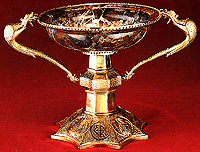 |
|
 |
The minor arts
 he creations
of the minor arts of the period that have survived are few. The difficult economic and political conditions of the timehave certainly played a part in he creations
of the minor arts of the period that have survived are few. The difficult economic and political conditions of the timehave certainly played a part in
 this scarcity. We know, for example, that many of these precious objects were either lost during periods of unrest, such as those of the civil wars, or the precious metals and other materials of which they were made were melted down to meet extraordinary financial needs. this scarcity. We know, for example, that many of these precious objects were either lost during periods of unrest, such as those of the civil wars, or the precious metals and other materials of which they were made were melted down to meet extraordinary financial needs.
Two characteristic works,
which constitute imperial offerings, give us a picture of the luxurious objects produced at the time. One is an ivory
pyxis,
now in the Dumbarton Oaks collection in Washington. On the side of the pyxis are represented two imperial couples with their young sons, musicians, dancers and a figure on his knees presenting a model of a walled city to one of the emperors. There are several views regarding the identity of the figures, however according to the prevailing one they are
John VII Palaiologos
and his uncle
Manuel II, who appointed his nephew as
governor of Thessalonike, the walled city presented by the kneeling figure to John. The shape of this small vessel and the material of which it is made recall certain earlier works of the 10th century.
The second object is the famous "Jasper" of the Vatopedi monastery on Mount Athos. This is a Chalice that belonged to
Manuel Kantakouzenos, the
despotes of Mistra from 1349 to 1380. It owes its name to the jasper, the dark-coloured stone with healing properties, of which it is made, and is ornamented with finely-worked gilded silver. The precious materials and the elaborate workmanship of this cup allows us to form some idea of the masterpieces of the minor arts that would have been fashioned for the court and the imperial family in the workshops of the Capital.
See also: 1st civil war (1321-28)
Manuel II Palaiologos
|